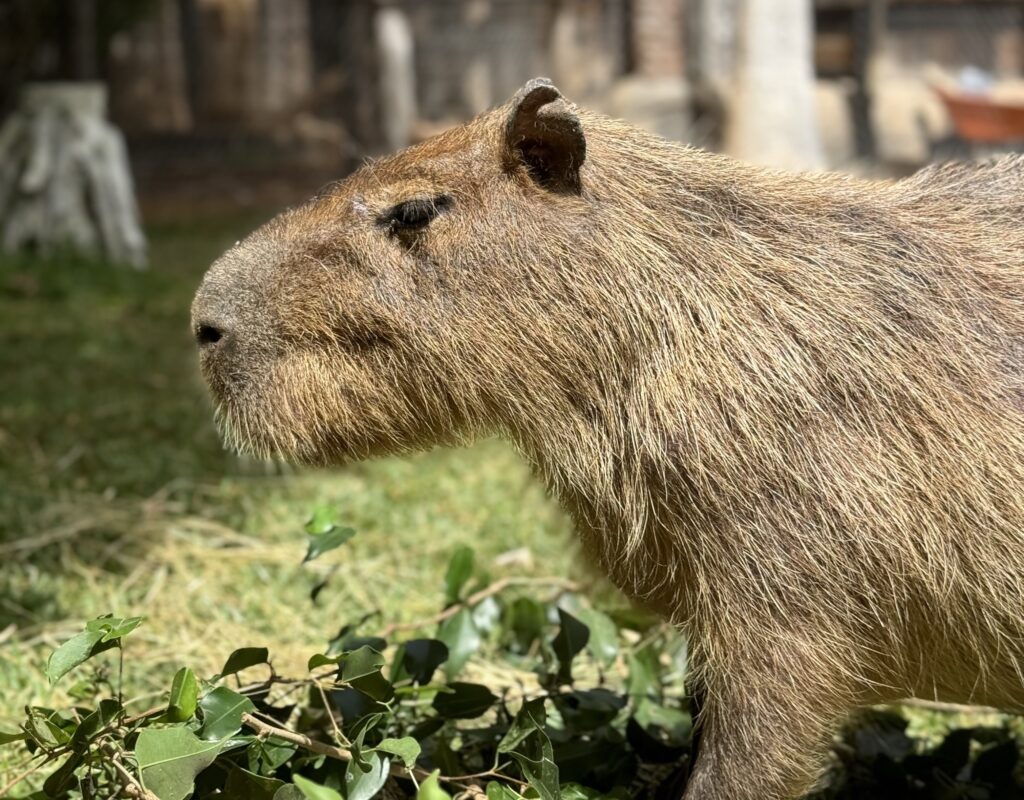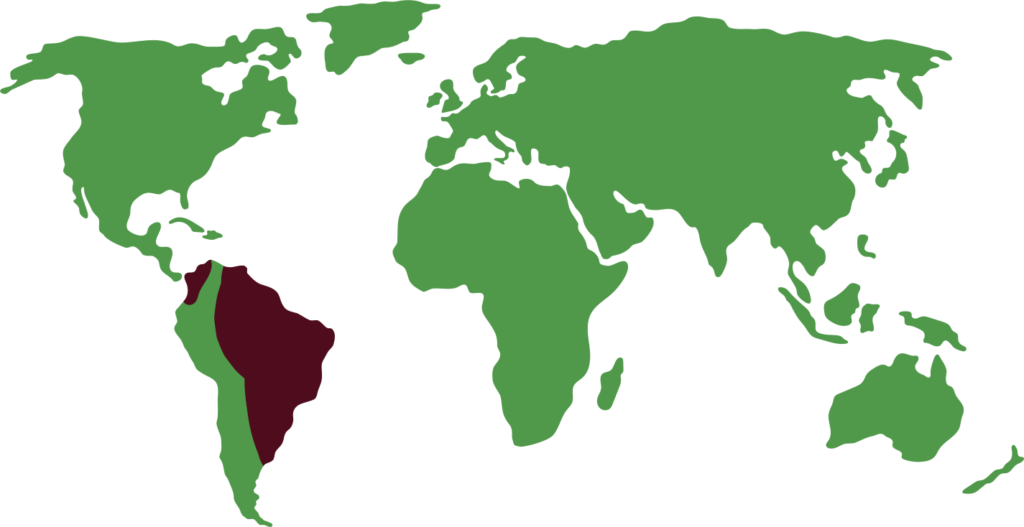CAPYBARA
Hydrochoerus hydrochaeris

Length

130 cm
WEIGHT

49 kg
lifespan

12 years
Capybaras are the largest rodents in the world. Native to South America, they prefer areas near water. They have robust bodies and are herbivores. They live in social groups of 10-20 individuals and usually breed once a year, with litters of 4-5 young.
General characteristics
Capybaras (Hydrochoerus hydrochaeris) are the largest rodents in the world. They prefer habitats near water, such as rivers, lakes and swamps, as they are excellent swimmers. They range in size from 35 to 66 kg, and can be up to 1.3 metres long, with stout bodies and short legs.
The capybara’s fur is long and rough, but in some areas it is so thin that the skin is visible. This makes them susceptible to sunstroke, so they cover themselves with mud to protect themselves from the sun. The colouring of the coat varies from reddish to grey on top, while the underside is yellowish-brown.
Capybaras have a large, broad head. Compared to their close relatives, their snout is larger and rounded. In males, the tip of the muzzle is bald and has a prominence related to the scent gland. The ears are small and rounded, and the eyes, also small, are located on the sides of the head. As in many animals with a partially aquatic lifestyle, the eyes, ears and snout of capybaras are located on the top of the head, allowing them to breathe and observe their surroundings while barely sticking out of the water.
Feeding
Capybaras are herbivores and their diet consists mainly of grasses, herbs and aquatic plants. They also consume tree bark and fruits when available.
Their digestive system is adapted to process large amounts of fibrous vegetation, allowing them to extract the necessary nutrients from their diet.
Behaviour
Capybaras are highly social animals that live in organised groups, usually consisting of 10-20 individuals, although they may form larger groups in areas with abundant food and water. These groups usually include a dominant male, several females and their young, as well as some subordinate males. Cooperation and communication among group members is essential for their survival.
These rodents are most active during dawn and dusk, when temperatures are cooler. During the day, they often rest in shaded areas or dive into water to regulate their body temperature. Capybaras are excellent swimmers and spend much of their time in the water, which provides protection from predators and helps keep their skin moisturised.
Capybara communication includes a variety of vocalisations, such as grunts, whistles and barks, which they use to coordinate activities and warn of potential dangers. They also use olfactory and tactile signals, especially in the case of males, who mark their territory with secretions from the olfactory gland on their snout. This complex network of interactions ensures group cohesion and mutual protection against external threats.
Reproduction
Capybara reproduction is seasonal, with females giving birth once a year. The gestation period lasts approximately 150 days, resulting in litters of 4-5 young. The young are born well developed and are able to move and swim soon after birth, giving them a survival advantage in their aquatic environment.
During the mating season, males emit vocalisations and secretions to attract females and establish dominance. After birth, females nurse their young for about four months, although the young begin to graze solid vegetation at a few weeks of age. The social structure of the group facilitates the care of the young, as other members of the group also help in their protection and feeding.
Threats
Capybaras face a variety of threats, both natural and human. In the wild, their main predators include jaguars, caimans and anacondas. However, the greatest threat comes from human activity, such as poaching for their meat and skin, and habitat destruction due to deforestation and agricultural expansion. In addition, pollution of water bodies negatively impacts their health and food availability. Despite these threats, capybaras are adaptable and still maintain healthy populations in several regions, although their conservation remains crucial.
Distribution
Capybaras are native to South America and are distributed in various regions of the continent, from Venezuela and Colombia in the north to Argentina and Uruguay in the south.
Although their geographic range is extensive, capybara populations may be affected by habitat fragmentation due to human expansion and other human activities. However, they are considered species of minor conservation concern due to their wide distribution and adaptability.

Did you know?
Capybaras are extremely social and can form groups of up to 100 individuals in areas with abundant food and water. These groups are hierarchically structured, with a dominant male leading and protecting the herd.
Capybaras are exceptional swimmers and can remain submerged underwater for several minutes. They use this ability not only to escape predators, but also to maintain their body temperature in hot climates.
Capybaras communicate using a wide range of sounds, such as grunts, whistles and barks, as well as olfactory and tactile signals. This communication is essential for coordinating group activities and alerting to potential dangers.
Conservation status
